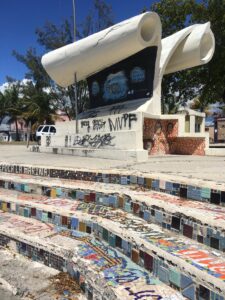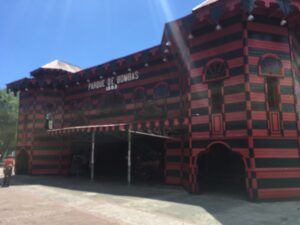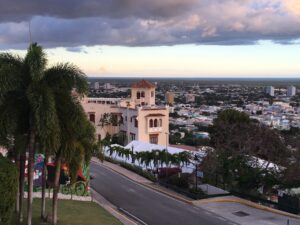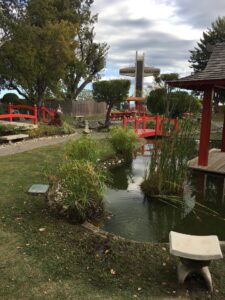
Amy and I began our day with a routine that had started to become our little tradition: a few sips of invigorating coffee followed by a dunk in our AirBnB’s little pool (la piscina pequeña de la casita blanca). As we were in the mountains, the pool’s water probably hovered somewhere in the 60s Fahrenheit, so the water definitely awakened all the senses; but once we got moving, the water started to feel warm, and it was so enjoyable getting the blood flowing in such a refreshing way.
Our fourth day in Puerto Rico, however, our first, real, hot day in the mountains. We generally had been somewhat surprised how cool it had been (to Minnesotans, of course, it felt positively, well, tropical), but this was the first time where the temperatures climbed into the 80s. This is something to be mindful of: if you travel to Puerto Rico during the winter months, you may want to bring along a fleece and some long pants in addition to lighter apparel, especially if your headquarters are in the mountains.
Following our morning routine, we began our excursion to Puerto Rico’s second biggest city, Ponce, named after Juan Ponce de León y Loayza, the great-grandson of Spanish conquistador Ponce de León. The city is located on the island’s southern coast, and while the city is only about 30 miles away from our AirBnB in Jayuya, the drive took about an hour and 15 minutes on account of the usual twisting, winding nature of the rural, mountainside roads.
As we neared Ponce, the roads gradually became wider and wider, the traffic faster and faster, and apart from the road signs written in Spanish, it felt like we were driving in any U.S. state (well, not any U.S. state on account of Puerto Rico’s gorgeous, gorgeous mountains). While the scenery continued to amaze us in its beauty, we did start to realize that we underestimated how much time we were going to spend driving on this trip. At the same time, we absolutely loved staying in Jayuya, tucked away in the mountains, away from all the other tourists. So, it’s something of a trade-off.

We initially arrived at the southeastern part of town, planning to enjoy lunch right away, and we decided to try a restaurant near a park right on the waterfront, Parque Pasivo Enrique González (possibly named after the Mexican poet, but I can’t find any confirmation of that). Viewing the map of the area led us to believe that the restaurant would have incredibly gorgeous views of the park and the sea, but when we arrived, we found the park a little unkempt and the restaurant set back from the oceanfront as to obscure any meaningful views.
We did, however, enjoy a walk around the neighborhood before we left for the more central part of town. But it was during this walk when I was reminded of a comment one of our fellow zipliners made the previous day, that government help following a major catastrophe (Hurricane Maria, for example), often goes towards the northern part of the island, especially San Juan, where all the tourists are (and even that aid was bungled by a moronic, idiotic, incompetent president who didn’t want to waste his time on “shitholes,” i.e. people who aren’t white). This southeastern part of town seemed to confirm this: abandoned buildings once maintained with colorful facades now fading, public art of colorful mosaics wearing away in a neglected park, padlocked doors to public restrooms.
So, we made our way towards Plaza de las Delicias (“Plaza of the Delights”), which is home to a number of landmarks, including Parque de Bomba (“Bomb Park,” Puerto Rico’s first ever firehouse but now a museum, apparently Ponce’s most photographed landmark, the structure instantly recognizable with thick, bold stripes of red and black running parallel to each other on the structure’s facade); Catedral Nuestra Señora de Guadalupe (a majesticly white neoclassical structure, its main entrance flanked by two square towers adorned with silver domes atop); and Plaza Muñoz Rivera and Plaza Degetau (two inviting squares adorned with grand fountains).

We soon turned our attention to lunch and discovered a little place called Chef’s Creations, and it was another good taste of authentic Puerto Rican food. We arrived right as they were closing (they finish the day after lunch), so we only had a handful of choices left. I opted for bistec encebollado (stewed steak and onions) and Amy and Aaron got something with grouper, but I’m forgetting the details. While the rustic patio that we dined in was somewhat memorable (there was a large baking tray fashioned into a chalkboard placed charmingly in a flowerbed that bid guests a farewell on their way out, “Gracias para venir nuestra casa,”) the rest wasn’t much to write home about. It wasn’t horrible, but it also wasn’t incredible.
Following lunch, we made our way to Castillo Serrallés (castillo means castle), a luxurious estate built in a Mediterranean hacienda style with a terra cotta roof and white stucco walls. It was built in the 1930s for Juan Eugenio Serrallés, son of Juan Serrallés who founded Destilería Serrallés which produces the Don Q rum (ron de Don Q). The business started in the 1830s refining sugar cane and then by the late 1800s began producing rum.
I just love visiting grand houses like Castillo Serrallés, and this house was no exception. Before the guided tour starts, on your own you can view the estate’s gardens, trimmed symmetrically with low hedges in simple arc-shaped designs complete with an opulent garden pool adorned with cherubs. The whole estate sits atop a large hill that overlooks all of Ponce, so even from the grounds of the garden you can appreciate views of not only the city but the ocean as well. That said, just right outside the grounds of the estate, small shanty towns struggle through their daily grind of inequity, and the contrast of rich and poor could not have been more starkly evident.

The guided tour of the inside of the house progresses much as these kinds of tours progress, complete with tidbit facts about the history of the house and its owners. After viewing a dated yet informative video of the history of la familia de Serrallés, a knowledgeable guide brings you room-to-room, viewing kitchens, bedrooms, dining rooms, grand hallways, all decorated gloriously and grandiosely with the original furnishings and photographs of the family. One of the highlights of the tour is stepping outside onto a large, upper terrace that provides even more incredible views of the surrounding gardens, the city of Ponce, and the ocean.
The inexpensive ticket to the house also allows you access to the nearby Jardín Japonés (an imitation Japanese garden that somehow seemed a little sad with its imitation zen gardens and imitation pagodas, yet it did have real koi and real bonsais, but otherwise if you don’t have time for this, you’re not missing much) and the the tall, concrete Cruz del Vigía (an ugly brutalist structure that wouldn’t be out of place in some U.S. college campuses, standing 110 feet tall, shaped exactly like a cross but somehow not a Christian structure at all, offering more stunning views of the city from the structure’s skywalk).
Beneath the cruz is a restaurant/bar with seating to continue to enjoy views of the city. We decided to treat ourselves to some mojitos, but the staff were either under-trained or spectacularly confused, as we were moved from one table to the next to the next, and then had to wait a half hour for our drinks to arrive. In the end, it was fine, as we weren’t pressed for time, but if you have a choice or are pressed for time, you can disregard the Jardín Japonés and Cruz del Vigía, and you won’t be missing much.
Following our excursions atop the hill, we made our way to Mesa Cocina y Vinatería, where we enjoyed our first, real, proper, ridiculously delectable and lustfully sinful meal during our adventures through Puerto Rico. When we arrived, I greeted the helpful staff with, “Buenas tardes! Una mesa para tres. No tengo una reserva,” to which I received a response, “Buenas noches! Is English easier?” Although, indeed, English was easier, it’s still really fun to try out as much Spanish as you can and see if it works (wrong time of day and all). Regardless, I really do think that you should learn as much Spanish as you can, as—while the locals in general are super friendly and switch to English as easily as night and day—I think you get extra bonus points if you can show you’re making a real effort with the language.
Meanwhile, nuestra ceda at Mesa was muy, muy deliciosa indeed! Naturally, we started with a bottle of rosé, then ordered aperitivos of tuna tartar, pork belly, and ceviche, then for our entradas enjoyed swordfish, tuna, and squid ink rice with a cornucopia of squid, mussels, and octopus. It was the best I had eaten in a long, long time, and I’d highly recommend a visit to Mesa to enjoy a really divine evening of comidas y bebidas.
As usual, we had over an hour drive back to Jayuya to nuestra casita en las montañas, feeling fully satiated and pleasantly satisfied, excited for the following day’s adventures in Puerto Rico’s largest city, San Juan…
Spanish lesson for the day:
- When you try to speak Spanish, some of the locals are good at catching on that it’s not your first language, so they may respond to your broken Spanish with, “¿Inglés?” or, “¿Habla inglés?” which is just, “Do you speak English?” I always respond with, “Si, lo siento,” which is, “Yes, I’m sorry,” and they switch to English as if flicking a switch.
- I wrote about how handy the verbs tener and queren are in my previous posts. Another good verb to know is pagar or to pay. “Quero pagar la cuenta,” is, “I want to pay the check.” “Pago la cuenta,” means, “I pay the check,” or, “I’m paying the check.” “Pagamos,” then is, “We pay.”
- Business hours are generally posted in Spanish, so you may want to learn at the bare minimum that lunes is Monday so that you can figure out what hours belong to what day. If they post a range, they’ll use the multi-use preposition a which is to. So, lunes a sábado is Monday through Saturday. All seven days are: lunes, martes, miércoles, jueves, viernes, sábado, domingo.
Travel tips, day four:
- If you plan to visit lots of different parts of the island but want to have a single place to stay, then plan to do lots of driving. While driving through Puerto Rico’s scenery has been so breathtaking, the amount of time it takes to get to our destinations was something we underestimated a bit. So take that into consideration when you choose where you want to stay. A 30 mile drive won’t necessarily be a 30 minute trip.
- When you’re in larger cities like Ponce and San Juan, the locals generally tend to default to English, even when you try to speak in Spanish. I still encourage you to learn a little Spanish, even the very basics that I wrote about on my post for día uno. That said, while I learned more than those basics, I feel that the locals are even more friendly due to the fact that I can say more than, “Gracias,” and “Buenos días,” even when I incorrectly conjugate the wrong verb.
- I strongly recommend a visit to Castillo Serrallés if you have time for nothing else in Ponce. You can buy tickets ahead of time using a third-party website.
